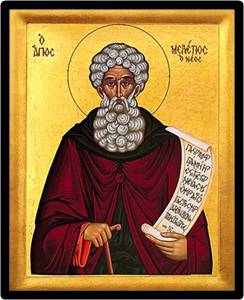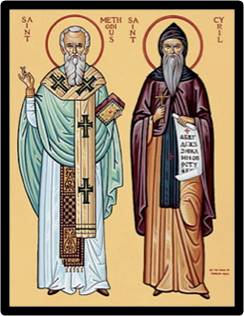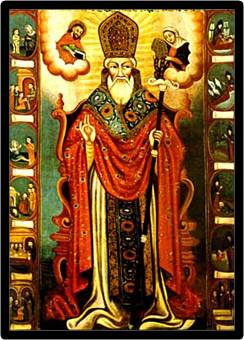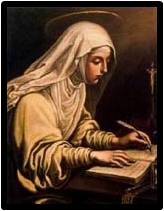
Meletius was born in the city of Melitene to one of the noblest families of Lesser Armenia. He was very pious and meek and became a priest.
Many years later, Meletius was made a Bishop of the Church. But this was not an easy task at all. The Church was divided. Some people were Catholic while others were Arian. The Arians refused to believe that Jesus was God and believed that he was only a man. They believed this only because things were not clear to them.
Bishop Meletius loved the Church and was true to Jesus. He believed that Jesus is God and realized that the Church would have to speak up clearly about who Jesus is.
When Meletius became bishop of Antioch the Arians were not pleased. For twenty years, Meletius was a patient, loving bishop who did his best to teach the people about the Holy Trinity. But his life was made difficult by people who did not like him.
He often had to go into hiding and live in the desert because other men were claiming to be the bishop of his diocese. But St. Meletius was the true bishop and would patiently return as soon as possible. When Emperor Valens died in 378, the Arians finally stopped harassing him.
In 381, the famous Council of Constantinople, a large Church meeting, was called. The bishops wanted to talk about important truths of our faith. Bishop Meletius opened the Church Council meetings and directed the sessions.
When the Arians were arguing about the Holy Trinity in a rude way, Bishop Meletius rose and showed the people who had asked for his teaching three fingers, representing the three Persons of the Holy Trinity; then, moving back two fingers, and leaving one in place, he blessed the people. At that moment a miracle happened and fire surrounded him, like unto lightning, and the holy Bishop cried aloud: “We understand three Persons and we speak of one God.”
Then, to the sadness of all the bishops, he fell ill and peacefully died right there at one of the meetings.
Great saints like John Chrysostom and Gregory of Nyssa attended his funeral along with all the bishops at the Council. His body was taken with honor to Antioch, where it was enshrined to defend the city for the glory of Christ our God, Who with the Father and the Holy Spirit is glorified forever.
The people of Constantinople poured into the church as well. St. Gregory of Nyssa spoke of a meek, Christ-like bishop whom everyone loved. And he was right: everyone who loved the Church loved St. Meletius.

Cyril and Methodius were brothers from Thessalonica in Greece. In their youth they learnt how to speak many languages, including Slavonic which at that time was not written down. Methodius was a provincial governor and the younger brother Cyril was a distinguished professor of Philosophy in Constantinople.
They both became priests and shared the same holy desires to spread the faith. Then the prince of Moravia asked for missionaries. He wanted them to bring the Good News of Jesus and the Church to his country. The prince added one more request: that the missionaries speak the language of his people.
The two brothers, Cyril and Methodius, volunteered and were accepted. They realized that they were being asked to leave their own country, language and culture behind out of love for Jesus. They did this willingly. They became missionaries to the Slav nations of Moravia, Bohemia and Bulgaria.
Cyril and Methodius invented a Slav alphabet. They translated the Bible and the Church’s liturgy into the Slav language. Because of them, the people were able to receive Christianity in words they could understand.
Some people in the Church at that time did not approve of the use of a native language in the Church’s liturgy and complained about the two brothers to the pope. Pope Nicholas I called them to Rome for a meeting to solve the problem.
But by the time they arrived, Adrian II had became pope and he was in favor of using the local language of the people in the liturgy. The pope showed his gratitude and admiration for the two missionaries. He approved their methods of spreading the faith and named them bishops.
Unfortunately, Cyril died on February 14, 869 before he could actually be consecrated a bishop and is buried in the Church of St. Clement in Rome. But Methodius became bishop, returned to the Slav countries and continued his labors for fifteen more years. He died on April 6, 885.
Cyril and Methodius were Greeks, under the authority of a Roman Pope, working together with the authorities of the Eastern Church. They symbolized bridge-building and connection between the two churches and are now seen as patron saints of ecumenism (unity) between the Eastern and Western branches of Christendom (Christianity).
St. Cyril and St. Methodius are also named co-patrons of Europe along with St. Benedict.




